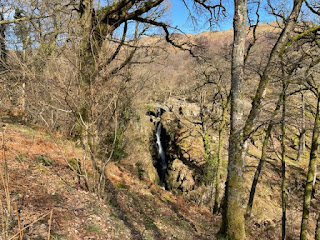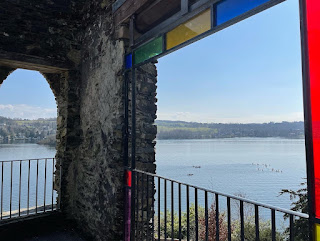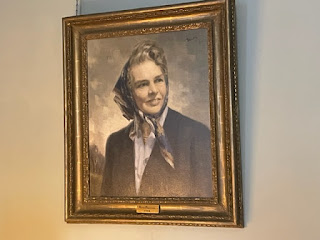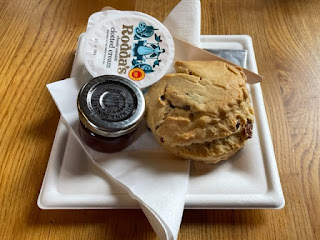Maybe it's the law that every waterfall has to be described as 'dramatic' and 'thundering' but I will be very, very honest with you, viewers: having read a bit about the place in advance, I was expecting
Aira Force to be a bit more of a force?
Due to a fallen tree, you can't access the viewing platform so you have to admire the falls from afar and then walk over them. This does diminish the impact a bit. BUT. It is very beautiful and the walks around the area are absolutely lovely.
William Wordsworth even wrote a poem about Airey-Force Valley (as he called it):
—Not a breath of air
Ruffles the bosom of this leafy glen.
From the brook's margin, wide around, the trees
Are stedfast as the rocks; the brook itself,
Old as the hills that feed it from afar,
Doth rather deepen than disturb the calm
Where all things else are still and motionless.
And yet, even now, a little breeze, perchance
Escaped from boisterous winds that rage without,
Has entered, by the sturdy oaks unfelt,
But to its gentle touch how sensitive
Is the light ash! that, pendent from the brow
Of yon dim cave, in seeming silence makes
A soft eye-music of slow-waving boughs,
Powerful almost as vocal harmony
To stay the wanderer's steps and soothe his thoughts.
The Aira Force Scone
I certainly needed to soothe my thoughts as I approached the cafeteria at Aira Force. I have to tell you that I could write a very lengthy thesis on the art and science of purchasing National Trust scones. People think it is easy. It is not.
The Aira Force scone is a great example of this. It was my second scone of the day, as we'd already stopped off at
Claife Viewing Station. This means that two completely opposing things occurred at the same time: on the one hand, my stress levels were reduced because one scone was already safely in the bag, so the trip wasn't going to be a complete disaster.
But! Because it was the second stop of the day, it was LATER in the day. I was now veering into mid-afternoon territory and that's a scary place for a Scone Blogger. It was also the warmest day of the year so far and the place was packed.
I joined the queue with a sense of foreboding and did a quick, subtle recce of the scone situation. In normal circumstances, the person with me is usually oblivious that we have now entered the critical moments of the scone mission. My friend Steph, however, is a very, very observant person. Within 3.5 seconds she had clocked the situation and turned to me and said "There are only two scones left".
The queue was long. The person at the front asked for a cream tea. Steph looked at me. The next person in the queue was querying out loud whether she whether wanted a cream tea or not....did she? Didn't she? She did. Steph looked at me.
We finally made it to the front. "Two cream teas please!" I chirped confidently, as if by not even acknowledging that no scones was possible, I could stop it happening. "You're lucky," said the very nice man. "These are the last two."
(I'd like to point out that Steph doesn't eat scones and there was no other food left so while I was gambolling triumphantly off across the patio with my baked items, she was making do with coffee. I probably wasn't empathetic enough about that, so sorry Steph.)
Anyway. It was a delicious scone and well worthy of 5 stars.
Aira Force and Ullswater: 5 out of 5
Scone: 5 out of 5
Food that wasn't a scone: 0 out of 5 (it was a very busy day)












